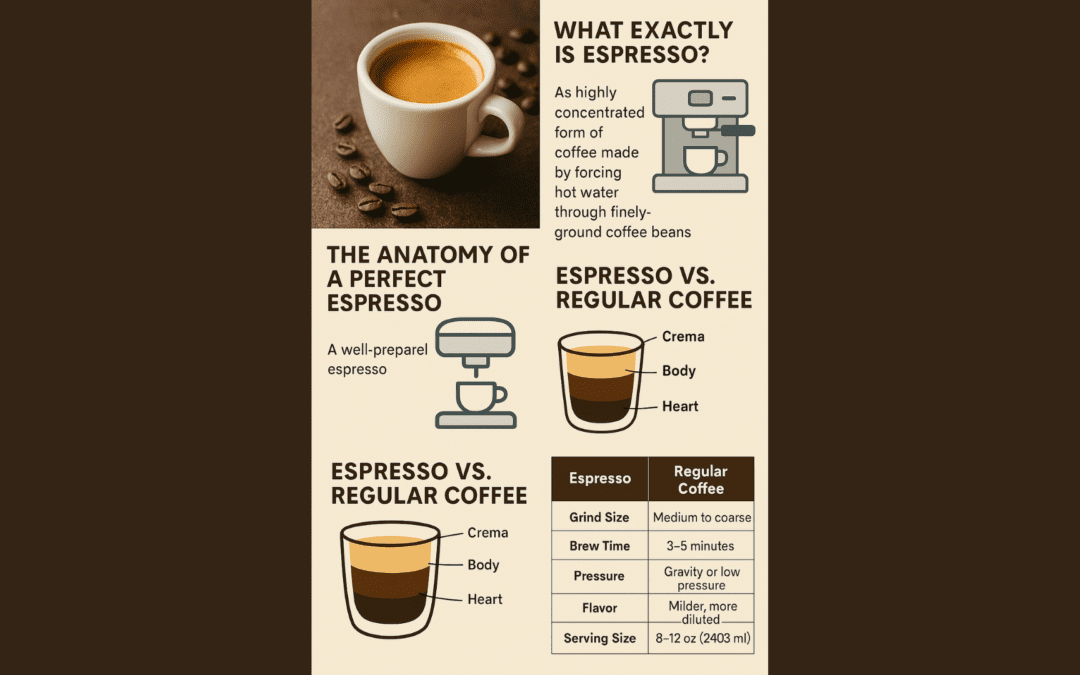What Is Espresso? A Bold Brew with a Big History
If you’ve ever strolled into a café and wondered what makes an espresso different from a regular cup of coffee, you’re not alone. This small but mighty brew is the heart of coffee culture around the world — and for good reason.
What Exactly Is Espresso?
Espresso is a highly concentrated form of coffee made by forcing hot water through finely-ground coffee beans at high pressure (typically 9 bars). The result? A rich, bold shot of coffee served in just 1 to 2 ounces. Despite its small size, it packs a flavorful punch that coffee lovers can’t get enough of.
Unlike drip coffee, which slowly filters water through coarse grounds, espresso is brewed in about 25–30 seconds, producing a dense, complex cup with a layer of golden crema on top — a creamy foam that’s considered a mark of quality.
The Anatomy of a Perfect Espresso
A well-pulled shot of espresso has three distinct layers:
- The Heart – the dark, rich bottom layer
- The Body – the middle layer, full of flavor and texture
- The Crema – a creamy, golden foam that sits on top and enhances aroma
These layers give espresso its signature balance of bitterness, acidity, and sweetness — and serve as the foundation for many classic drinks.
Espresso vs. Regular Coffee
So, how does espresso differ from your average cup of joe?
| Feature | Espresso | Regular Coffee |
|---|---|---|
| Grind Size | Fine | Medium to coarse |
| Brew Time | 25–30 seconds | 3–5 minutes |
| Pressure | High (9 bars) | Gravity or low pressure |
| Flavor | Bold, concentrated | Milder, more diluted |
| Serving Size | 1–2 oz (30–60 ml) | 8–12 oz (240–360 ml) |
A Foundation for Favorites
Espresso is the base for most specialty coffee drinks, including:
-
Latte – espresso + steamed milk + light foam
-
Cappuccino – espresso + equal parts steamed milk and foam
-
Macchiato – espresso with just a dollop of milk foam
-
Americano – espresso diluted with hot water
Whether you prefer your coffee straight up or with milk and foam, it all starts with that little shot of espresso.
A Shot of History
Espresso dates back to early 20th-century Italy, where inventors like Luigi Bezzera and Desiderio Pavoni revolutionized coffee brewing with pressure-based machines. What began as a quick coffee for workers (“espresso” literally means “pressed out” in Italian) evolved into a global ritual — from the cafés of Rome to coffeehouses around the world.
Final Sip
Espresso is more than just a coffee; it’s a craft, a culture, and a canvas for creativity. Whether you enjoy it solo or as part of your favorite latte, understanding what goes into this tiny cup can deepen your appreciation for the rich world of coffee.
So next time you hear that familiar pssst from an espresso machine, you’ll know — that little shot holds big flavor and even bigger history.

